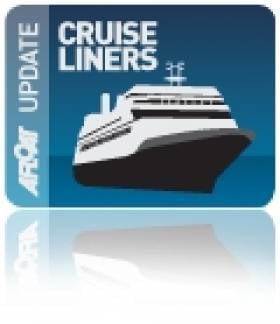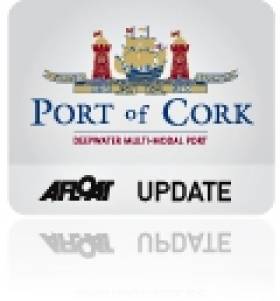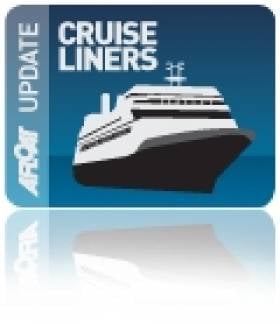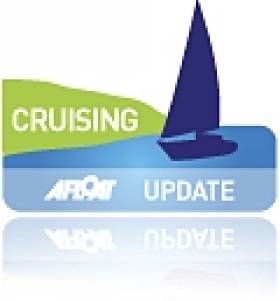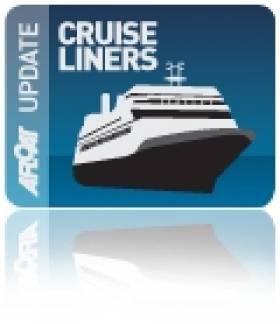Displaying items by tag: Cruise
Dun Laoghaire Yacht Clubs Voice Concern Over Plan
Dun Laoghaire Yacht Clubs are voicing concerns about the impact on sailing if a 'cruise ship jetty' is constructed as part of the recently published harbour masterplan.
Dublin Bay Sailing Club, Dun Laoghaire Motor Yacht Club, National Yacht Club, Royal Alfred Yacht Club
Royal Irish Yacht Club and Royal St George Yacht Club. are also concerned about access to the water if a proposed 'pedestrian walkway' in front of the waterfront clubs was completed.
The clubs have engaged 'professional help' to prepare a submission to outine the concerns.
Also seen as a problem is the 'lack of sufficient facilities in the masterplan for hosting significant international sailing events'.
A survey in 2009 by the Irish Marine Federation (IMF) calculated a €3million spend by participants connected with the 500-boat Volvo Dun Laoghaire regatta. The clubs have previously stated they see the harbour's future as a leisure facility.
A masterplan model was on display by the Harbour Company in the month of August.
Writing to members in the current edition of the National Yacht Club's newsletter commodore Paul Barrington says the clubs 'hope to further engage with the harbour [company] to find a mutually acceptable way forward'.
Water Rat: Harbour Plan is a Curate's Egg
Queen Elizabeth Arrives on Dublin Bay
First Cruise-Caller of the Year
Onboard the ship which caters mostly for the UK market, asides the interior facilities there are the outdoor leisure amenities located on the Lounge Deck which has two jacuzzis and an exercise pool. There is also a large swimming pool and weather permitting a poolside buffet is also available at meal times. In addition a circular pool is located on the Marque Deck.
She alongside sister Black Watch belong to a four-ship fleet of the Norwegian owned company. Boudicca was built in 1973 and for many years served as Royal Viking Star as part of a trio of German built sisters for Royal Viking Line. The 205m long vessel underwent her last major refit in 2006.
Boudicca will remain berthed in Dublin's Alexandra Basin until she sets sail later this afternoon for the short overnight cruise-leg to Liverpool.
Last year Dublin Port handled 88 cruisecalls and this number of cruise-callers is to be closely repeated in 2011. Overall there will be over 200 cruise calls with around half a million passengers and crew scheduled to visit ports and anchorage locations throughout the island of Ireland. The cruise sector business is estimated to generate €60m to both the northern and southern economies.
Clarion Hotel Promotion for Port of Cork Marina Visitors
Captain Pat Farnan, Port of Cork Harbour Master said: "The Port of Cork opened this new marina in 2010 and experienced a busy summer of visitors. We are aiming to attract more local and visiting boats to the marina this summer and we feel the joint promotion with the Clarion Hotel will be very effective."
He continued: "We hope to do further promotions around the marina throughout the summer."
The Port of Cork City Marina is ideally located in the heart of Cork City offering 150 metres of berthage with 24hr security, water, and electricity and refuse facilities. The Clarion Hotel is within 100m of the Port of Cork City Marina, making it ideally located for marina users who want to use the shower facilities.
The Port of Cork City Marina is a long term investment for the City of Cork which the Port of Cork implemented as part of their Leisure and Recreation Strategy for Cork Harbour. The primary focus of the strategy is on water based Leisure and Recreation activities in and around Cork Harbour in which the Port of Cork aims to play a leading role in providing and supporting improvements of amenities in these areas.
Cork Harbour offers significant potential for further development of the marine recreation sector as an important source of enjoyment and economic gain for the local residents and visitors. The Port of Cork, primarily providing commercial services to its customers, is conscious of its responsibility to all other stakeholders in Cork Harbour.
In Cork, the world's second largest natural harbour, it is critically important for both commercial and leisure to work together in harmony. The Port of Cork is committed to achieving this while also respecting the principles of environmental sustainability and corporate social responsibility.
Operating guidelines and charges for the Port of Cork City Marina are HERE
Cruise Line Business Worth €60m
There are many indirect economic and tourism benefits to Ireland from this sector, as well as the benefit of introducing Ireland to new markets and business opportunities. Such cruise visits also help to showcase Ireland's world class shore products, destinations and highlights all that Ireland has to offer visitors.
One of Ireland's advantages is the strategic and geographic spread of its numerous ports, many of which are in close proximity to world class tourism destinations.
Speaking at Seatrade Miami this week, the Chairman of Cruise Ireland, Mr Brendan Keating said "Cruise Ireland aims to promote the island of Ireland as an excellent cruising ground for cruise companies. With the total economic contribution of €60 million, we need to ensure that Ireland maintains this level of business and looks at methods of growing it in the future."
He continued; "Cruise Ireland is looking forward to the 2011 season with confidence. We expect to see further growth in ship calls and the continued establishment of Ireland as an important cruise liner destination. Marketing Cruise Ireland at Seatrade will hopefully encourage further cruise bookings to Ireland in 2012 and 2013."
Representatives from Cruise Ireland attended Seatrade Miami to promote the Island of Ireland as a cruise line tourism destination. This event is attended by over 10,000 delegates, cruise line operators, the world's leading cruise tourism destinations and 118 countries.
Each year, all of the international operators including Princess Cruises, Royal Caribbean, Cunard, Holland America Line and NCL visit Irish ports to access Ireland's world class destinations.
The 2011 season will kick off in early April with calls by the MV Queen Victoria to Cork, the MV Boudicca to Dublin and the MV Ocean Nova to Belfast
Historic Trophy for South Pacific Dream Cruise
Fergus and Kay Quinlan live in the Burren in County Clare, and in 1997 they launched the steel van de Stadt 12-metre cruiser Pylades, which they'd built themselves. They've made several voyages and have been in the Irish Cruising Club's award list before. But at the ICC's AGM in the National YC on February 18th they deservedly got the big one, the Faulkner Cup, for the first stage of a global circumnavigation which began from their home port of Kinvara in the summer of 2009, and a year later they'd reached Tahiti.
Their cruise continues, so the award was made in absentia. Adjudicator Brian Cudmore of Cork made the point that their informative log included much general and often entertaining information, and it becomes even more interesting the further you got into it, so he's keenly anticipating the next inmstalment.
The Strangford Cup for an alternative best cruise could not have been more different, both in location or boat type. The 44ft Young Larry may have been built of steel in 1995, but she was based fairly precisely on the design of a gaff cutter built in 1907. And though the rig has been made more manageable through being a yawl, even the mizzen is gaff-headed, while the main sets a topsail. Not the most-easily handled rig for challenging seas, you might well think, but Maire Breathnach (originally from Dungarvan) and her partner Andrew Wilkes, crewed by Maire's niece Sibeal Turraoin, took Larry Og – which looks for all the world like a smaller Asgard I – right through the Northwest Passage to Alaska, an extraordinary one-season achievement.
The ICC members logged some other notable Atlantic voyages, with Michael Coleman of Cobh, a Port of Cork Pilot before he got the free bus pass, making a fine Atlantic triangle to the Azores, then Newfoundland, and so home to Cork, visiting many islands with his well-found 1988 Oyster 53 Oyster Cove. It was all done with a crew of average age 66, senior member Tom Noonan aged 76, and worthy winners of the Atlantic Trophy.
Over the years since its foundation in 1929, the Irish Cruising Club has become the trustee and adjudicator of many trophies, twenty in all, and two of them were special presentations in 2010. The Donegan Memorial Trophy went to Ruth Heard, an ICC member since 1967. She has cruised both to the Azores and Iceland, but is honoured this year in celebration of her remarkable contribution to the rebirth of the inland waterways, and to mark the re-opening of the Royal Canal. Ruth Heard was on the crew of Harklow, the last boat to transit the Royal in 1954 before its half century of official closure which was gloriously reversed in 2010.
And once upon a time, the ICC was the organiser of Ireland's Admiral's Cup campaigns. Though many members still race offshore as individuals, the club has long since focused totally on cruising. But it has a general trophy, the John B Kearney Cup for Services to Irish Sailing, and for 2010 it was awarded with acclamation to the successful Irish Commodore's Cup Team.
- Faulkner
- Cruise
- Cruising
- Cup
- Club
- Quinlan
- Kay
- Fergus
- ICC
- National
- yacht
- cub
- YC
- Cudmore
- Cork
- Breathnach
- Alaska
- Asgard I
- Strangford
- Burren
- Pylades
- Northwest
- Passage
- Wilkes
- Sibeal Turraoin
- Coleman
- Atlantic
- Cobh
- Newfoundland
- Oyster Cove
- Oyster
- Donegan
- trophy
- Ruth Heard
- John B Kearney
- Cup
- Commodore's
- gaff
Superyacht Fleet Expected to Visit London Olympics then Ireland
London is expected to provide a great SuperYacht venue for the Olympics and the hope is that some of the massive visitors may in turn continue cruising in Ireland according to www.YachtsLondon.com who are providing services to help yachts arrange to visit in 2012.
There are only a handful of capital cities that can accommodate SuperYachts in their hearts and London is one of these with its iconic river views of Tower Bridge, Greenwich, the O2 Dome and the Canary Wharf financial district.
A legacy of London's place at the centre of world trade in the past are its remaining docks which will provide high quality stern-to mooring for 50-100 large yachts as demand warrants. Canary Wharf will be the centre of this with added space in the Royal Docks next to City Airport. Yachts up to 200m LOA and 30m beam can be accommodated.
Hugh Agnew, one of the principals of YachtsLondon said that "many parties will be involved including dock owners, landowners, pier operators, PLA, MCA, security and suppliers. We can help with all of these, but the key at the moment is early decisions so that sufficient dock space is put in place for 2012."
As well as the Olympic Games there are many other events in the UK in 2012 including Superyacht Cup, J Class regattas, Westward Cup so if there was ever a year to plan to make UK the destination then 2012 will be it with the possibility to link to cruising in Ireland, Scotland and Scandinavia.
Waterford Club Plans June Scilly Isles Cruise
Although Waterford Harbour Sailing Club is well known for its dinghy sailing and picturesque location it has never really been seen as a hub for sailing cruisers.
Consequently there has never been a big event for the big boats at the club but, says club secretary Rene Wubben, that's about to change this season with a Scilly Isles Rally from Dunmore East in June.
Waterford Harbour is keen to attract as many boats as possible from its own club but also others nearvy for the cruise in company that departs Dunmore East on June 16th. More info from Waterford Harbour Sailing Club. Tel: 051 383389
2011 Afloat Almanac: If you're contemplating a cruise, short coastal passage or even just studying for a Nav course this season, don't forget the 2011 edition of the Afloat Irish almanac (with Reeds Data). It covers the whole of Ireland, the Scottish, English and Welsh West coasts. Buy it online. CLICK HERE Easy!
Come Cruising at the Holiday World Shows
The following ferry, cruise and specialist travel companies exhibiting at the Belfast venue are: DFDS Seaways (formerly Norfolkline), Celebrity Cruises, Complete Cruise Solution, Cruise & Maritime Voyages, Cunard, Norwegian Cruise Line, P&O, Princess, Pullmantur Cruises, Regent Seven Seas Cruises, Royal Caribbean Cruise Line, Seabourn, Silverseas Cruises, The Cruise Machine (trading as Vamos Holidays) and Voyages To Antiquity.
On the following weekend, The Holiday World Show in association with The Sunday Times will be held on 28, 29 and 30 January at the RDS Simmonscourt, Dublin, which incorporates the Caravan & Motor Home Show.
Like the Belfast show The World World Show in Dublin will have numerous exhibitors with worldwide destinations and all types of holidays on show. The following ferry, cruise and specialist travel operators will be exhibiting: Azamara Cruises, Celebrity Cruises, Celtic Link Ferries, Cruise & Maritime Voyages, Cruise Holidays, Travel.ie, Hurtigruten, John Galligan Travel, MSC Cruises, Princess Cruise Lines, Pullmantur Cruises, Regent Seven Seas Cruises, Royal Caribbean Cruise Line, Saga, Silversea Cruises, Thomas Cook and Voyages To Antiquity. Also at the show will be Emerald Star for those interested in taking a cabin-cruiser holiday on the Shannon.
Visitors to the Holiday World Show Dublin can attend cruise talks hosted by the Eoghan Corry Free Expert Clinics during the three-day long show. For a full listing of exhibitors, ticket prices, opening hours and further information about both shows logon to www.holidayworldshow.com




























